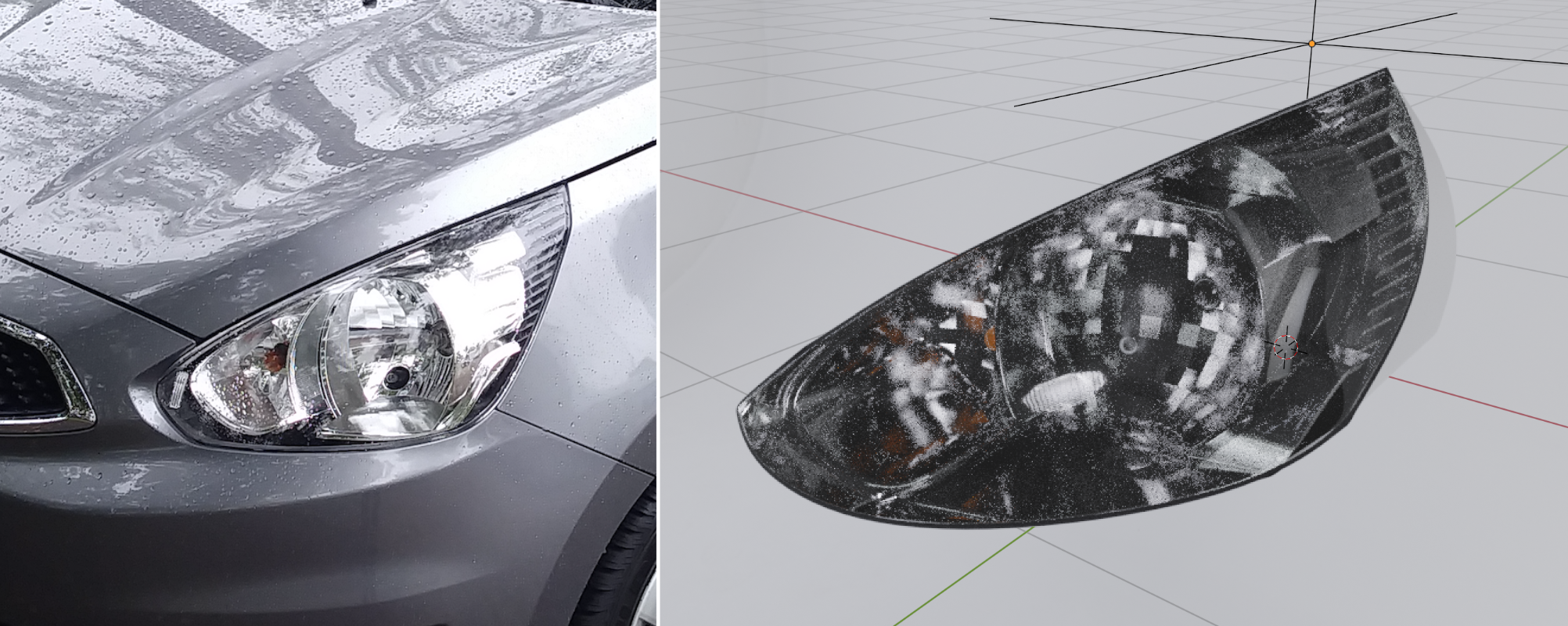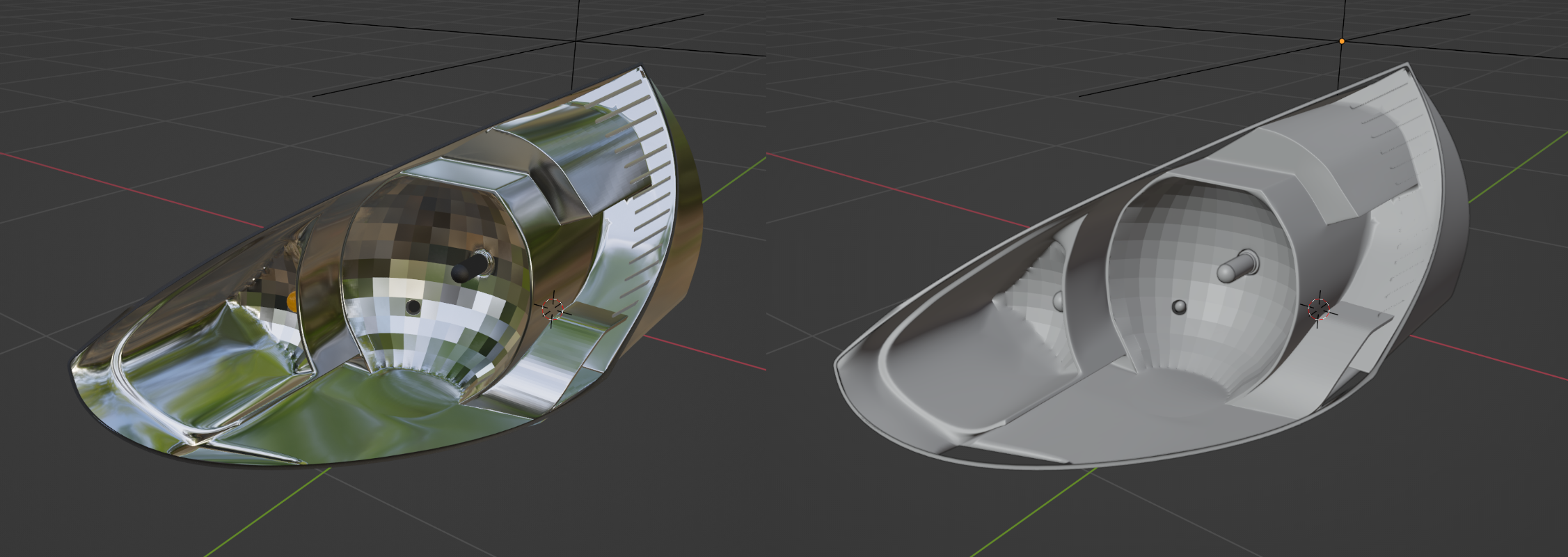nicerdicer
I’m also @nicerdicer@feddit.de
- 2 Posts
- 8 Comments
I start with the easiest part: The gas tank cap on the rear left side and the towing hook cap on the right front bumper. These parts were done surprisingly fast (15 min. each). Also the lock on the drivers door (5 min.).
Most tedious: the windshield wipers. Mostly because they were so small compared to the rest of the cars parts, which made it hard to navigate and zoom (already switched the units to millimeters, but still), and all three (2 in front, 1 in back) were individually shaped, so no mirror modifier could be applied). I just had to pull through during weekdays evenings. I would guess it took me 10 hours for all of them.
Medium: the front bumper with the fog lights and the lower grille as well as the upper grille: This took me a whole Saturday and Sunday; the upper grille was made during the weekdays - I would say 3 - 4 hours.
Hard: the inner structure of the front light. I had multiple photos of the light from top, side, front, etc. The main problem was that this thing is made of chrome (and plastic probably) which it made it hard to see the form/shape. And since everything else is made with eye measure, I had to alter the size and proportions to fit into the model. The problem was that when I (thought) I was finished, it stuck out of the side of the front glass cover. So I had to scale it down and had to re-arrange everything. I also made some simplicfications for the reflector. In the model it looks more like a disco ball. That is not the case with the real thing, but it was easier to merge a sphere with extruded lines to archive the relector-type appearence. See photos. This part took me the longest. I would guess it took the whole weekend (Saturday and Sunday) as well as some days during the week - approximately 25 - 30 hours.


My only question is why that car?
I own this car. It was easy for me to get photos of various things that helped modelling the structure.
without a doubt the worst vehicle I’ve ever driven
I’ve driven worse. But I can see your point. Compared to other cars there is not much comfort in driving. You always have to account for the price this vehicle is being sold (for this model in particular the price for a brand new car was at 10.000 €, with the most basic trim an the basic 1-l-engine). However, my car even has AC (for overtaking another vehicle one needs to switch it off so you have more power to the engine) and electric windows (but no switch on the drivers side for the passenger door). And it has a real dashboard with the instruments on the drivers side behind the steering wheel and a glove box with lid on the passenger side. Most small cars have that weird arrangement where the instruments are located in the center console and just a shelf for a glove box. When I was in Bavaria with its hill topography I had to even shift into lower gears on the autobahn because the engine is so weak - a thing which todays cars is not usual anymore. But fuel consumption ( - 4.8 l/100 km or 49 MPG) as well as maintenance (no issues so far at - 120.000 km or 74564 miles) and taxation is very wallet friendly - and it beats walking!

 1·2 years ago
1·2 years agoCorrect. The said vending machine was collecting data without users consent. And because it was facial recognition data it means that the collected data can be tied to an individual.
It would have been different if the collected data was just a counter which indcated the number of users of that machine. These kind of data could not have been tied to a specific individual.

 5·2 years ago
5·2 years agoThat is correct. Switzerland is not a part of the European Union. The manufacturer, Invenda, is located in Switzerland. That is where their headquarters are. It might be possible that their vending machines are produced within the EU (another country where production costs are lower). It might be possible that these specific models (those who offer data collection) are designed for markets outside of EU.
They advertise their product as “Made in EU” (see brochure). This could be made on purpose to implicate that their data collection meets GDPR requirements, leading to believe that everything is compliant with the law.

 11·2 years ago
11·2 years agoBad news, the manufacturer is located in Switzerland and, as stated in the brochure, they advertise their product as “Made in EU”. Probably to implicate that any data which will be collected and processed will be under the terms of GDPR.
I haven’t looked up the terms regarding GDPR, but I assume that their data collection is somewhat “compliant” with GDPR, which does not necessaryly mean anything. It can just mean that data is not stored locally, albeit it will be send to the manufacturer (but probably entcrypted). However, under GDPR you can enforce your right of deletion of the collected data - that is, if you know that data about you has been collected.
What makes this issue so severe is that it would have never been detected that data has been collected and processed, if it weren’t for a malfunction.
Edit: grammar, spelling

 85·2 years ago
85·2 years agoThe worst part of all is that no one would think of the fact that a vending machine is performing facial recognition techniques, because in general it is assumed that a vending machine is a mechanical device, as it has been in the past. There is not any user benefit in that.
I researched the manufacuter and in their brochure (see page 6) of a similar vending machine it is revealed what data can be processed:
Among the worst data sets are:
- product demographics
- measuring of foot traffic
- gender/ age/ etc.
Bonus: on page 7 of the product brochure they introduce an app which allows the customer to make purchases directly from their smatphone, with features like
- consumer engagement through gamification, interactive marketing, gifting, scratch-and-win receipts, product sampling and cross selling
“What do customers get?”
- a fun and engaging payment process
Finally! I always thought that payment is not fun enough. What a time to be alive.

 10·2 years ago
10·2 years agoAs for an addition to the topic I leave this link to a study which gives some insight to consuming behavior:
Signaling Status with Luxury Goods: The Role of Brand Prominence

There is an eerie resemblence between the smallest neuron and the largest structure in the universe - Galaxy Filament